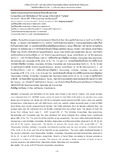| dc.description.abstract | ศึกษาองค์ประกอบและการแพร่กระจายของปลาวัยอ่อนในอ่าวไทย บริเวณจุดเก็บตัวอย่างรวม 45 สถานี ระหว่างวันที่ 14 มีนาคม – 11 เมษายน 2556 โดยเรือสำรวจ M.V. SEAFDEC การเก็บตัวอย่างประกอบด้วย 1) การลากแพลงก์ตอนในแนวเฉียง ตั้งแต่ ผิวน้ำจนถึงระดับความลึก 10 เมตรเหนือระดับพื้นทะเลโดยใช้ถุงแพลงก์ตอนแบบ Bongo ที่มีขนาดตา 500 ไมครอน ขนาดเส้นผ่านศูนย์กลาง 55 เซนติเมตร และ 2) การเก็บตัวอย่างบริเวณผิวน้ำโดยถุงแพลงก์ตอน Neuston ขนาดตา 1,000 ไมครอน พบปลาวัยอ่อนทั้งหมด 9,882 ตัวอย่าง เป็นตัวอย่างจาก ถุงแพลงก์ตอนแบบ Bongo 9,486 ตัวอย่าง และ ถุงแพลงก์ตอน Neuston 396 ตัวอย่าง ปลาวัยอ่อนที่พบสามารถจำแนกได้เป็น 65 วงศ์ ตัวอย่างจากถุงแพลงก์ตอนแบบ Bongo พบปลาวัยอ่อน 64 วงศ์ มีความหนาแน่น ระหว่าง 0 - 2,297 ตัว/ปริมาตรน้ำทะเล 1,000 ม.3 วงศ์ที่พบปริมาณมากที่สุดได้แก่ Gobiidae, Engraulidae Bregmacerotidae, Nemipteridae และ Carangidae เท่ากับ 28 %, 15 %, 7 %, 7 % และ 6 % ของปลาวัยอ่อนที่พบทั้งหมด ส่วนวงศ์ที่มีการแพร่กระจายมากที่สุดได้แก่ Gobiidae, Carangidae, Bothidae, Engraulidae และ Bregmacerotidae พบจาก 41, 39, 36, 34 และ 33 จุดเก็บตัวอย่างตามลำดับ ตัวอย่างจากถุงแพลงก์ตอนแบบ Neuston พบปลาวัยอ่อน 28 วงศ์ มีความหนาแน่นระหว่าง 1 – 45 ตัว/ปริมาตรน้ำทะเล 1,000 ม.3 วงศ์ที่พบปริมาณมากที่สุดได้แก่ Teraponidae, Mullidae, Gobiidae Carangidae และ Excoetidae เท่ากับ 27 %, 12 %, 11 %, 10 % และ 8 % ของปลาวัยอ่อนที่พบทั้งหมด ส่วนวงศ์ที่มีการแพร่กระจายมากที่สุด ได้แก่ Teraponidae, Mullidae, Excoetidae, Carangidae และ Haemirhamphidae พบจาก 18, 16, 15, 14 และ 12 จุดเก็บตัวอย่าง ตามลำดับ ปลาวัยอ่อนที่ได้จากถุงแพลงก์ตอนแบบ Bongo โดยการลากในแนวเฉียงมีความหลากหลายและปริมาณมากกว่าการเก็บโดย Neuston net บริเวณผิวน้ำ โดยตัวอย่างจาก Neuston net มักพบปลาวัยอ่อนขั้นหลังและปลาระยะวัยรุ่นมากกว่าโดยเฉพาะกลุ่มปลาผิวน้ำ เช่น Haemirhamphidae, Belonidae และ Exocoetidae
Composition and distribution of fish larvae were studies in the Gulf of Thailand. Fish larvae samples were collected from M.V. SEAFDEC cruises during 14 March-11 April 2013 at 45 stations by plankton tows using Bongo net and Neuston net. Bongo net with 55 cm diameter mouth opening and 500 micron mesh was used for
oblique hauls, while Neuston net with 1000 micron mesh was used for surface horizontal hauls. A total of 9,882
larval fishes were caught, representing 65 families. The 9,486 individuals from 64 families collected from the oblique hauls and 396 individuals from 28 families collected from the surface hauls. The density of total fish larvae from oblique hauls were 0 - 2,297 larvae/1,000 m3. The Gobiidae, Engraulidae, Bregmacerotidae, Nemipteridae and Carangidae were the most abundant fish larvae obtained from oblique hauls, contributed about 28%, 15 %, 7 %, 7 %, and 6 % of the total fish larvae, respectively. The most widely distributed families in oblique hauls were Gobiidae, Carangidae, Bothidae, Engraulidae, and Bregmacerotidae, observed in 41, 39, 36, 34, and 33 of 45 stations, respectively. The density of neuston fish larvae were 1–45 larvae/1,000 m3. The Teraponidae, Mullidae, Gobiidae, Carangidae, and Haemirhamphidae were the most abundant, contributed about 27 %, 12 %, 11 %, 10 %, and 8 % of the total fish larvae, respectively. The most widely distributed families in the neuston collections were Teraponidae, Mullidae, Excoetidae, Carangidae and Haemirhamphidae, observed in 18, 16, 15, 14, and 12 of 45 stations, respectively. Diversity of larval fishes was greater in oblique samples as compared to surface or neuston samples. The neuston net samples a higher proportion of larger larvae or juvenile, especially the pelagic fishes, Haemirhamphidae, Belonidae and Exocoetidae | en |

